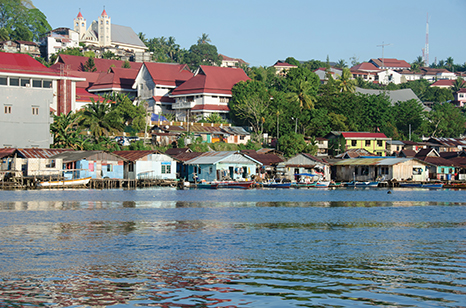An unintended stop leads to new friends and a fixed boom in this interesting Indonesian city (published May 2015)
We arrive in Jayapura by accident when a storm forces Jim and me to abandon our 955-mile passage from Ninigo, a remote atoll in Papua New Guinea, to Palau, the westernmost part of Micronesia. Tenaya, our floating home, is tied to a small, battered Coast Guard boat in the filthy harbor of this bustling Indonesian city. Normally we make landfall with local guidebooks, maps and a dictionary. This time we have nothing.
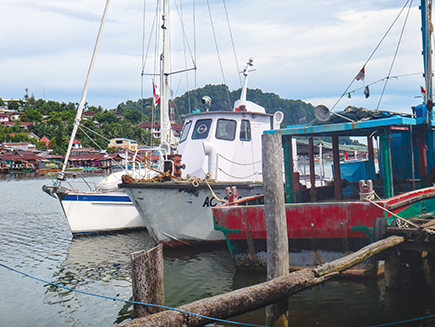
We are pleased when the captain, Iwan, invites us to tie our boat to his. Otherwise, we would have to anchor in 40 meters with no safe place to leave our kayak ashore. Ghersom is the captain of the new Coast Guard vessel in front of us. He speaks English well and gives us directions to the Immigration office. He changes his mind a couple of times, a sure bet it won’t be easy to find. I ask him to write the name of the landmark hotel before we head off in the direction he points. In the stifling heat, Jim wears long pants and I wear a skirt because brown-nosing can’t hurt with government officials.
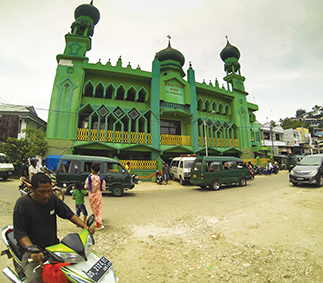
Two main streets run parallel to the harbor in the center of Jayapura. Two others bisect these. When we reach a street with hotels, we turn up but do not find Hotel Dafansoro as directed. I ask a policeman sitting beneath an awning and he points across the street. We blame our stupidity on sleep deprivation.
The immigration office is closed because it is Saturday, but construction workers are revamping the entrance. They find a man there on his day off who leads us to his office. “May I see your passports?” he asks. We hand them over. “May I see your CAIT?” We say we don’t have one. He frowns. This cruising permit is mandatory for boats entering Indonesia. We explain that we did not mean to come to Indonesia. We were sailing from Papua New Guinea to Palau and ran into bad weather. A part on our boom broke and we were running out of fuel. Coming here was our best option.
He perks up at the mention of a broken part. “So it is an emergency?” he asks. “Oh yes,” we answer. He seems offended that we don’t want to be here so I say, “We are traveling from PNG to Palau, then to the Philippines, then to Borneo. We will enter Indonesia in Kalimantan, on Borneo, next year. Then we will have our CAIT.” He understands and finally smiles. He calls a colleague who arrives with his wife. Her head is wrapped in the Muslim fashion, with a hijab. This man takes our passports, says he will process them on Monday, and gives us a ride to our boat so he can photograph the damage.
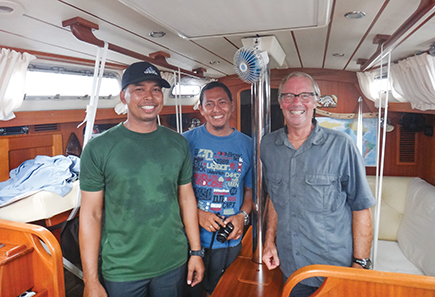
Anton and Dadang, from the Navy, arrive dressed in T-shirts, shorts and flip-flops. They look around inside and Anton asks, “Do you have weapons on board? Do you have narcotics?” We do not. As they climb up the companionway stairs, he asks to see our ship’s papers. He and Ghersom look them over carefully.
Before Jim can repair the pin at the gooseneck, Iwan’s friend arrives. With no English spoken, he makes it clear he can repair the old pin. He uses a cut-off drill bit to replace the lost retaining post, pulls a portable welder out of his backpack, and welds them together. Then he steps onto Tenaya. Soon the boom is reattached and stronger than ever. Jim asks where we can buy solar (diesel) and Iwan motions to his boat. Yippee! Clean fuel is hard to find here. The welder, another man, and Iwan, fill and ferry 140 liters in four 20-liter jugs while Jim pours the fuel into our tank. Hot, sweaty and dizzy with vertigo, I am sprawled out on our bed with the fan on and a spray bottle nearby—no help whatsoever.
Papua shares the second largest island in the world, after Greenland, with Papua New Guinea. Each time new colonizers come, the land gets a new name. The simple version is that the Portuguese came first, followed by the Spanish, then the Dutch. In 1962 Indonesia took over and in 1973 named this area Irian Jaya. Native Papuans share nothing ethnically or culturally in common with Indonesians and still refer to this land as Papua. Most people of Indonesian descent worship Islam while many of the indigenous Papuans are Christian. We meet people of both races and religions; all are friendly and welcoming.
Jim and I return to the Immigration office to collect our passports and sit next to another white couple. They are missionaries who have just completed translating the New Testament to the informal Indonesian language. They are called, do their business, and leave. Another white couple comes up and sits near us. They, too, are missionaries. We wonder if people think we are missionaries.
It takes four hours to complete our business. We have each been granted a 30-day Visa on Arrival (VOA) but are told we must leave once the repair is completed. We take a taxi to a specific bank to pay $50 for each VOA then take the receipt back to Immigration. The bank has a policy of not accepting folded one hundred dollar bills. I show the man that all my money is folded, that is how it fits in my small wallet. Eventually he accepts it.
The officials want Jim to stamp the forms with our boat stamp. We don’t have a boat stamp. We’ve managed to sail 38,000 miles without ever needing one. Several shopkeepers offer to make ours within the hour and we kill time talking to guys eating food from a cart built on a motorcycle.
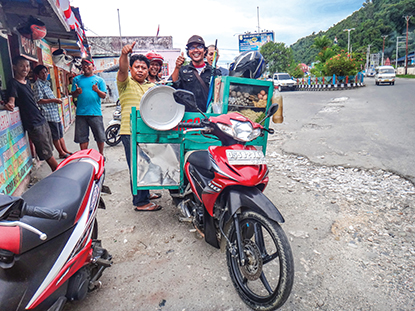
There are food stands, carts and shacks everywhere. It doesn’t appear people eat meals at home. The food is cheap and the rats are plump. Near the port is a small stand on the side of the road that sells fresh reef fish each afternoon. People pull up on their motorcycles, buy their dinner, and are off in a few minutes.
It’s noisy and crowded in Jayapura. Beeping horns compete with calls to prayer that begin at 4:15 a.m., blast throughout the day, and finally end sometime after 7:00 p.m. Traffic is heavy with taxis speeding and motorcycles weaving. We don’t notice any accidents. The only ambulance we see is the one we ride in to meet the Health official. His office is in a plush new building halfway to the airport. Instead of driving to the shabby satellite office near the port, he has the ambulance driver deliver us.
Hoping to get Internet access on the boat, we go to the Telkomsel office to buy a dongle and SIM card. A cheerful young woman named Happy says the service is not reliable so Jim and I have lunch each day at the air conditioned Hotel Yasmin and use their sluggish Wi-Fi. On the fifth day the server asks where we are staying. We’re not sure he understands that we live on a sailboat so that evening we print a picture of Tenaya to show him.
One day the wind picks up and Iwan says we need to move. Our boat is bashing against his boat, which is bashing against the seawall. He says to follow him to Dock 9, Bitang. We cross the harbor littered with thousands of plastic bags and bottles and head into a small bay at the far end. The water’s edge is lined with houses on stilts. Many have the motorized canoes with double outriggers tied in front. There is a long open building with a few recreational motorboats moored to a rickety wooden dock. A navy boat is tied to a large orange rescue boat. Iwan pulls up to a fishing boat behind them and we secure Tenaya to his boat again.
Iwan introduces us to a man who will provide security. A little while later we hear someone on deck. I climb up and see several men on the Coast Guard boat looking at Tenaya. Some are fishing, all are smoking. One man is standing near our cockpit. I ask him to leave and try to explain this is our home. He looks sheepish and climbs off. Iwan and the security guard are nowhere to be found.
This location is more public than the last. I have to spread fabric down from the bimini and across the windshield so we can sit in the cockpit without being stared at by kids and adults clustered on the Coast Guard boat. The moment the fabric falls or a window opens, our view is filled with curious, prying faces.
One day we take a taxi to Hamadi three kilometers south of the city center. There are several Papuan craft shops here selling carved wooden statues, stone axes, bark paintings, woven bags, drums, gourds and a multitude of things made from dead animal parts.
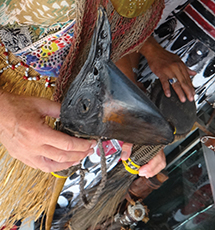
Jim is intrigued by the weapon made from a cassowary. These tall, flightless birds have a unique crown and are protected in Australia. The handle is the bird’s head and the dagger is a leg bone chiseled to a sharp point. It is interesting in a National Geographic kind of way, but I could not imagine it sitting on a shelf when we get back home. I’m certain our son, who will not eat meat of any sort, would not approve.
The shopkeeper takes some delight in dressing me up in as many dead things as he can find. He ties a headdress around my forehead made from an entire bird-of-paradise, wings, feathers, head, beak and all. Gum shells make a pretty pattern on the band. It is heavy and itchy and I imagine all kinds of creepy things crawling into my hair. He drapes fabric woven from dead plants over my shoulders and wraps more around my waist. He ties bands of feathers around both biceps and hangs a heavy shell necklace around my neck. I pose just long enough for Jim to take a few photos and wonder if he does this to all the middle-aged white women tourists. 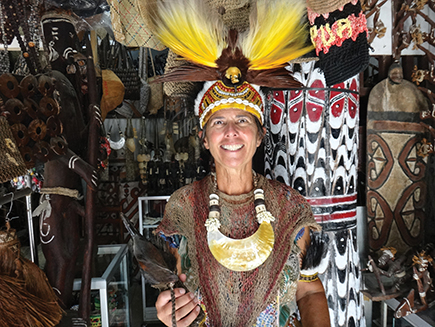
One evening a long outrigger pulls up between Tenaya and the military boats. A guy hops out and delivers a dozen fresh fish to the rescue boat. We take pictures and print one for them. A few days later Iwan says he wants to take his friends fishing. It is a holiday—the last day of Ramadan. The bay is choppy and the wind is howling. He says he will be back at 10 p.m. We let him out, retie to the fishing boat, and can’t remember the last time we stayed up that late.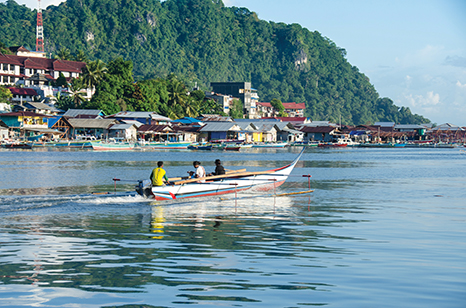
Joyo is a mechanic on the navy boat. It has been his home for eight years. His Facebook name is one of the characters in Pirates of the Caribbean so I give him a skull and crossbones hat and scarf. He puts them on and doesn’t take them off.
He gives me an Indonesian to English pocket dictionary and later his dog tags. There is no ID tag, instead a design representing Allah, and the tag of his first ship. I am touched. This is the only religious thing aboard Tenaya. I hope it keeps us safe when we continue our passage north towards the typhoons.
Udin and Ahmad from the Rescue boat have never been inside a sailboat before. After we all take photos I say, “You’ve seen our boat, can we see yours?” I am surprised when they say yes.
The weather looks good to leave on October 17 so the day before we go to Immigration, the Coast Guard and the Harbormaster to checkout. The harbormaster says he can act for the Health Officer, which saves us another ambulance trip. He says he must see Tenaya to make sure our boom is fixed before he will sign us out. Could he seriously think we would want to sail 800 miles with it still broken?
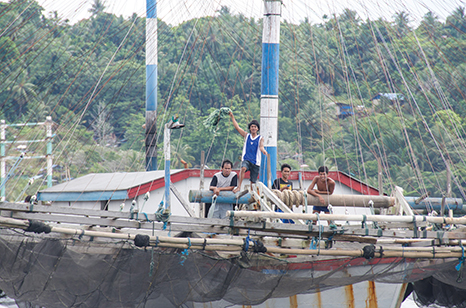
Jim and Katie Thomsen received the Ocean Cruising Club’s Rambler Medal for 2012 in recognition both of their cruising among the islands of Vanuatu and their positive actions once ashore. As they sail west, they continue to delve deeply into the waters and cultures they visit. Katie chronicles their adventures at www.tenayatravels.com.















